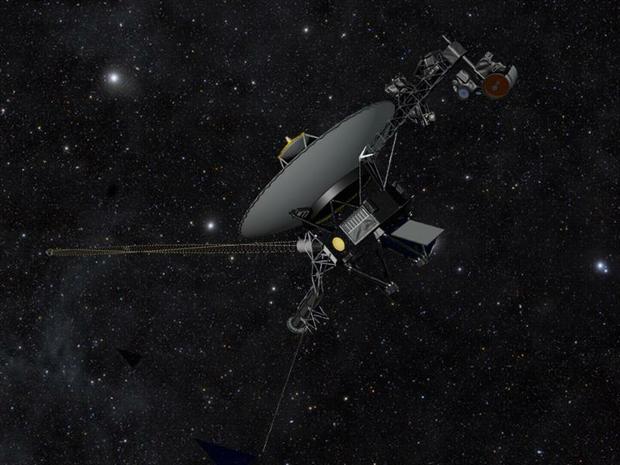There is no 'you are now exiting the solar system' sign at the entrance to interstellar space, so when, and perhaps if, Voyager 1 left the solar system remains a mystery - but a team says it has definitely happened by now.
Voyager 1, carrying with it Earthly greetings on a gold plated phonograph record, still-operational scientific instruments and the future plot of "Star Trek: The Motion Picture", has traveled farther from Earth than any other human-made object.
But has it left the solar system? NASA says no while a group writing in The Astrophysical Journal Letters says their model of the outer edge of the Solar System shows Voyager 1 actually entered interstellar space a little more than a year ago. NASA says the experiment is still in a fuzzily-defined transition zone between the Sun's sphere of influence and the rest of the galaxy.
At issue is what the boundary-crossing should look like to Earth-bound observers 11 billion miles away. The Sun's envelope, known as the heliosphere, is relatively well-understood as the region of space dominated by the magnetic field and charged particles emanating from our star. The heliopause transition zone is both of unknown structure and location.
According to conventional wisdom, we'll know we've passed through this mysterious boundary when we stop seeing solar particles and start seeing galactic particles, and we also detect a change in the prevailing direction of the local magnetic field.
NASA reported that last summer, after eight years of travel through the outermost layer of the heliosphere, Voyager 1 recorded "multiple crossings of a boundary unlike anything previously observed." Successive dips in, and subsequent recovery of, solar particle counts caught researchers' attention. The dips in solar particle counts corresponded with abrupt increases in galactic electrons and protons. Within a month, solar particle counts disappeared, and only galactic particle counts remained. Yet Voyager 1 observed no change in the direction of the magnetic field.
To explain this unexpected observation, some hypothesize that Voyager 1 has entered a "heliosheath depletion region" but that the probe is still within the confines of the heliosphere.
Lead author Marc Swisdak, of the University of Maryland, and colleagues are not part of the Voyager 1 mission science teams and have another explanation. Their previous work focused on magnetic reconnection - the breaking and reconfiguring of close and oppositely-directed magnetic field lines. It's the phenomenon suspected to lurk at the heart of solar flares, coronal mass ejections and many of the sun's other dramatic, high-energy events. They argue that magnetic reconnection is also key to understanding NASA's surprising data.
Though often depicted as a bubble encasing the heliosphere and its contents, the heliopause is not a surface neatly separating "outside" and "inside." Swisdak, along with fellow plasma physicists James F. Drake, also of the University of Maryland, and Merav Opher of Boston University, assert that the heliopause is both porous to certain particles and layered with complex magnetic structure. Here, magnetic reconnection produces a complex set of nested magnetic "islands," self-contained loops which spontaneously arise in a magnetic field due to a fundamental instability. Interstellar plasma can penetrate into the heliosphere along reconnected field lines, and galactic cosmic rays and solar particles mix vigorously.
Most interestingly, drops in solar particle counts and surges in galactic particle counts can occur across "slopes" in the magnetic field, which emanate from reconnection sites, while the magnetic field direction itself remains unchanged. This model explains observed phenomena from last summer, and Swisdak and his colleagues suggest that Voyager 1 actually crossed the heliopause on July 27, 2012.

Voyager 1, artist's conception. NASA/JPL-Caltech
In a NASA statement, Ed Stone, Voyager project scientist and a professor of physics of the California Institute of Technology, says, "Other models envision the interstellar magnetic field draped around our solar bubble and predict that the direction of the interstellar magnetic field is different from the solar magnetic field inside. By that interpretation, Voyager 1 would still be inside our solar bubble. The fine-scale magnetic connection model [of Swisdak and colleagues] will become part of the discussion among scientists as they try to reconcile what may be happening on a fine scale with what happens on a larger scale."
Voyager Interstellar Mission
In the 36th year after their 1977 launches, the twin Voyager 1 and 2 spacecraft continue exploring where nothing from Earth has flown before. Their primary mission was the exploration of Jupiter and Saturn. After making a string of discoveries there -- such as active volcanoes on Jupiter's moon Io and intricacies of Saturn's rings -- the mission was extended. Voyager 2 went on to explore Uranus and Neptune, and is still the only spacecraft to have visited those outer planets.
The current mission for both spacecraft, the Voyager Interstellar Mission, is to explore the outermost edge of the Sun's domain and beyond. Both Voyagers are capable of returning scientific data from a full range of instruments, with adequate electrical power and attitude control propellant to keep operating until 2020.
Preprint: M. Swisdak, J. F. Drake, M. Opher, 'A Porous, Layered Heliopause', arXiv:1307.0850
Citation:
M. Swisdak, J. F. Drake, M. Opher, 'A Porous, Layered Heliopause', The Astrophysical Journal Letters Volume 774 Number 1 doi:10.1088/2041-8205/774/1/L8






Comments